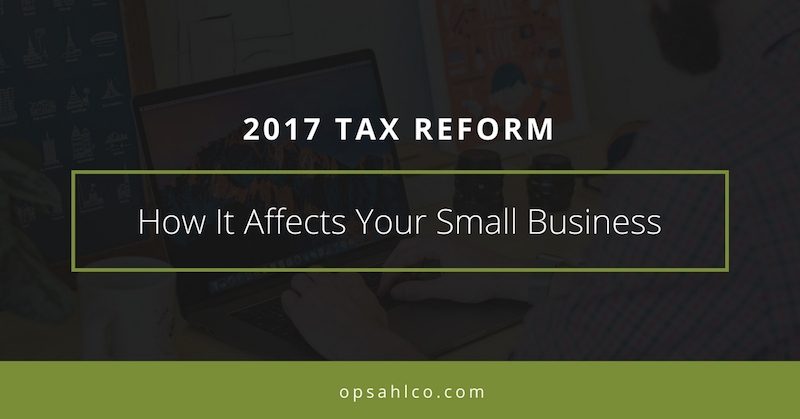The 2017 tax reform legislation affects more than just C Corporations– it also means changes for small businesses here in Washington and throughout the US. Are you aware of these changes and how they can save you money?
The team at Opsahl Dawson is here to help you navigate the waters. In this article we’ll use a fictional example of Goldilocks, a hair salon owner, to explain the new law and how it affects small businesses.
The New Qualified Business Income (QBI) Deduction
As of Jan. 1, 2018, Section 199A allows certain small businesses to take a 20 percent deduction. This new Qualified Business Income (QBI) deduction is calculated by multiplying a business’s QBI by 20 percent and is deducted directly on Form 1040.
The new QBI deduction is available to taxpayers with business income from:
- S Corporations
- Partnerships
- Limited Liability Companies not taxed as a C Corporation
- Sole proprietorships reported on Schedule C
- Rental properties reported on Schedule E
- Farm businesses reported on Schedule F
- (Additionally, investors that own REIT stock or interests in Publicly Traded Partnerships (PTPs) are also available to receive the QBI deduction)
For Goldilocks, our hair salon owner, her QBI deduction is 20 percent times the net income shown on Schedule C.
Owners of S Corporations and Partnerships, on the other hand, will claim their deduction on their individual income tax return. Their return will be based on the amounts shown on their Schedule K-1 for trade/business income, rental income, and gain/(loss) from the sale of business property.
QBI only includes a business’s domestic income from a US source. Employee wage income and partnership guaranteed payments are not included in QBI.

Understanding QBI Deduction Limitations
There are three limitations to the new QBI deduction. These include:
- Taxable Income Limitation
- Wage Limitation for Taxpayers with Taxable Income over Threshold Amount
- Limitation on Specified Service Businesses
Let’s take a look at each of these limitations in more detail.
Taxable Income Limitation
The QBI deduction will be the lesser of:
- 20 percent of the owner’s QBI; or
- 20 percent of taxable income computed without the QBI deduction and reduced for qualified dividends and long-term capital gains
Wage Limitation for Taxpayers with Taxable Income over Threshold
Married taxpayers who are joint filing with a taxable income greater than $415,000 ($207,500 for all other taxpayers), the QBI deduction is limited to the greater of:
- 50 percent of the business’s W-2 Wages; or
- 25 percent of the business’s W-2 Wages plus 2.5% percent of the original cost of qualified businesses property.
If a married taxpayer is joint filing and has taxable income greater than $315,000 ($157,500 for all other taxpayers), this limitation is phased-in. There are also tax planning opportunities for those who exceed the $315,000/$157,500 thresholds.
Taxpayers who own rental property typically don’t have W-2 Wages for their income, so their limitation will be based on 2.5 percent of the original cost of the qualified business property.

Limitation for Specified Service Businesses
There are certain types of businesses that, under certain earnings circumstances, will not qualify for the QBI deduction. These businesses include:
- Health
- Law
- Accounting
- Actuarial science
- Performing arts
- Consulting
- Athletics
- Financial services
- Brokerage services
- Any trade or business where the principal asset of such trade or business is the reputation or skill of one or more of its employees,
For any of the above businesses, there is no QBI deduction if their taxable income, before considering the deduction, exceeds the $415,000/$207,500 threshold.
However, if these taxpayers have a taxable income less than $315,000/$157,000, the deduction is allowed in full. Furthermore, the limitation will be phased-in for those with taxable income between $315,000/$157,500 and $415,000/$207,500. However, tax planning opportunities do exist for those that exceed the $315,000/$157,500 threshold.
Note: Engineers and architects are not subject to this limitation.
So, How Much Will Small Businesses Save?
Let’s take a look at Goldilocks, the hair salon owner, for a better look at how this QBI deduction will affect small businesses.
Goldilocks operates her hair salon as a Sole Proprietorship. She nets $100,000 after deducting one-half of her self-employment tax and also claims the standard deduction of $12,000. ($100,000-$12,000 standard deduction = $88,000 taxable income.)
Goldilocks’ QBI deduction is $17,600 (20 percent of taxable income of $88,000) as this is less than $20,000 (20 percent of her QBI). Her income tax savings from claiming this deduction will be approximately $4,000. However, the QBI deduction does not reduce Goldilocks’ self-employment tax.

Stay Informed of New Changes, Take Advantage of Savings
The new QBI deduction calculation isn’t simple, but it will be a benefit to many small business owners. Currently, the deduction is set to expire at the end of 2025. So, as a small business owner, it’s important to find out if you qualify for the deduction and stay aware of any new updates or guidance on the topic.
If you have questions about the new tax reform legislation or need help filing your taxes, talk to us. Our Certified Public Accountants are here to encourage and help you take advantage of the best short and long-term benefits available for you and your business.
Learn more about our award-winning tax planning services by watching the video below.
This post adapted from Megan Lawsons’ original article published in Vancouver Business Journal.








Leave A Comment